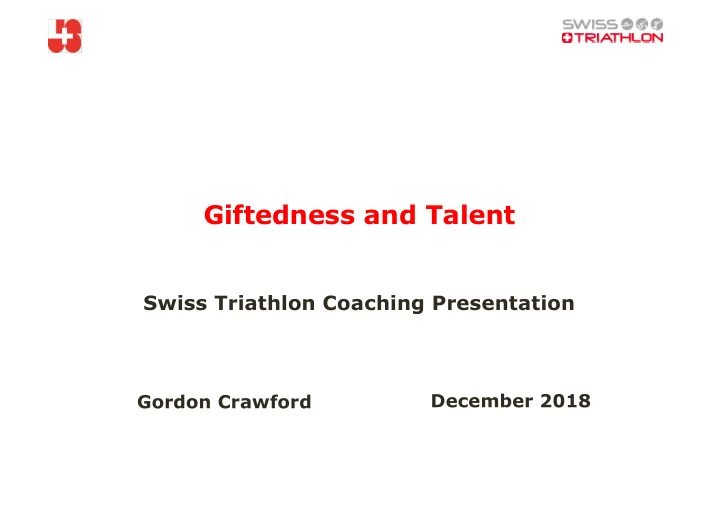

Giftedness and Talent Swiss Triathlon Coaching Presentation December 2018 Gordon Crawford
‘The Artist is nothing without the gift, but the gift is nothing without the work.’ Emile Zola
A model worth considering in the development of athletes is: Gagné’s Differentiated Model of Giftedness and Talent (DMGT)
Gagné differentiates clearly between – ‘Gifts’ (natural abilities) AND ‘Talents’ (systematically developed from gifts)
According to Gagne, gifts are natural inborn attributes, which a person possesses in one or more domains. There are 6 domains and they fall into either mental capabilities or physical controls. Mental capabilities are intellectual, creative, social and perceptual. Physical capabilities include muscular and motor control. In order for both attributes to be considered gifts, the natural abilities must be 10% higher than their peers within the same age grouping.
Gifts are what Gagne considered to be ‘raw capacity’. Learning , practice and training is the development process that an athlete must undertake in order for the potential to be reached and ultimately for the gifts to become talents. Mansfield, 2009 states that ‘ talents ’ are ‘ specific expert skills .’
The Differentiated Model of Giftedness and Talent (DMGT) presents the talent development process (P) as the transformation of outstanding natural abilities, or gifts (G), into outstanding systematically developed skills which define expertise, or talent (T) This developmental sequence constitutes the heart of the DMGT.
Development of Gifts The development of gifts can be hindered by 2 different catalysts: Environmental Intrapersonal
The Differentiated Model of Giftedness and Talent (DMGT) Three types of catalysts help or hinder that process: (a) Interpersonal (I) catalysts, like personal traits and self - management processes (b) Environmental (E) catalysts, like socio - demographic factors, psychological influences (e.g., from parents, teachers, or peers), or special talent development facilities and programmes (c) Chance (C)
Natural Abilities Gagné lists four domains of natural abilities, of which 3 are mental and 1 Physical, which according to him are mostly genetically determined: MENTAL Intellectual abilities - reasoning, memory, sense of observation, judgement, and metacognition. Creative abilities - inventiveness, imagination, originality, and fluency. Socio-affective abilities - perceptiveness, communication (empathy and tact), and influence.
Natural Abilities Gagné lists four domains of natural abilities, of which 3 are mental and 1 Physical, which according to him are mostly genetically determined: PHYSICAL Sensorimotor abilities which may include; sensitivity (the senses), strength, endurance, coordination and others. Muscular – Power, speed strength and endurance Motor Control – Speed (reflexes), agility, coordination and balance
Talent The different fields are open to wider argumentation than the natural abilities. Gagné thinks the following fields are relevant for school-aged youths: Sport and Leisure Academics Arts, Business, leisure, Social affection
Developmental Processes Informal - as the learning of a first language by a child Or Formal - as most learning in school - and practice gifts don't turn into talents.
Developmental Processes These can be categorised as the following – Activities Progress Access Stages Content Pace Format Turning Points Investment Time Money Energy
Gagné thinks that all talents are developed from natural abilities through learning influenced by inner and outer catalysts. The main components of Gagné's model - which he refined several times, are : Environmental Catalysts Intra-personal Catalysts Chance
Intra-personal Catalysts Several characteristics of the person influence the learning process positively or negatively. Physical characteristics like health Motivation and volition, Self-management, Personality (temperament, self-esteem, adaptability).
Environmental Catalysts Gagné names four groups of environmental influences on the development of talents: Milieu or social environment (culture, background – family and context) Individuals (Parents, family, teachers, coaches, mentors) Provisions (Programmes, Enrichment, Activities, Pacing, Grouping and Services) Events
Chance One last factor influencing the catalysts (intrapersonal and environmental) and the natural abilities (gifts) is chance. More importantly, chance determines through the recombination of paternal genes which types of giftedness a child possesses and to what extent.
‘ Coaching is the universal language of CHANGE and LEARNING.’ (CNN) ‘A coach is someone who can Give correction without resentment.’ (Coach John Wooden)
‘A good coach can change a GAME. A great COACH can change a LIFE.’ Coach John Wooden
Recommend
More recommend